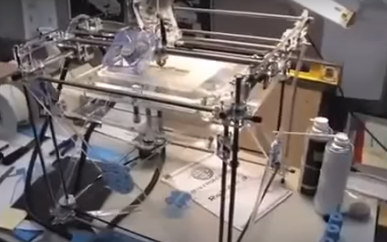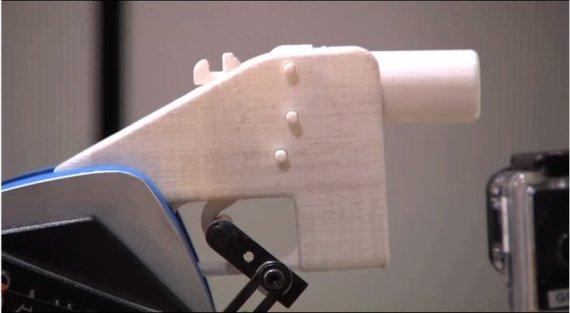 It’s no secret that criminals enjoy technology and the ‘next best thing’ as much as the law-abiding folk. And just because they are bad guys doesn’t mean they can’t harness serious savvy and skill, as well as being able to leverage some serious cash. As we’ve been told, crime never sleeps, nor do the software and hardware those operating on the wrong side of the courts have working tirelessly for them, whether in warehouses, basement offices, or dusty terrorist caves on the other side of the world. Many today see criminals as ruining the fun for everyone else when it comes to 3D printing and guns.
It’s no secret that criminals enjoy technology and the ‘next best thing’ as much as the law-abiding folk. And just because they are bad guys doesn’t mean they can’t harness serious savvy and skill, as well as being able to leverage some serious cash. As we’ve been told, crime never sleeps, nor do the software and hardware those operating on the wrong side of the courts have working tirelessly for them, whether in warehouses, basement offices, or dusty terrorist caves on the other side of the world. Many today see criminals as ruining the fun for everyone else when it comes to 3D printing and guns.
Sparking off a huge controversy from the start–no surprise there–the fabrication of guns has made many people very aware of 3D printing, where they otherwise may have not heard of it so early on.
We’ve been following the topic of 3D printing and guns around the world as governments and law enforcement officials weigh in–and react. Australia parliaments began considering anti-3D printing laws for guns early last year as they became more aware of the technology–and exactly how easy and affordable it is to use in making weaponry. 3D printed guns were found in a raid in February, and further inquiries have been launched but just last month it was divulged that many senators still think existing gun laws are enough.

The NSW Police Department actually tried their hand at 3D printing guns and were surprised to see how fast and affordable the process is.
The New South Wales take on the issue has been in the news as they’ve had a hardnosed reaction to gun and weapon enthusiasts within their country who have an affinity for mixing that particular passion with 3D printing–and indeed a passion it has to be, because while learning to 3D print may not be rocket science, the making of guns takes some know-how and requires brains in your operation. No matter the case, the New South Wales Parliament in Australia isn’t having it.
NSW is the first to pass a law restricting the possession of files for 3D printing weapons, having approved the Firearms and Weapons Prohibition Legislation Amendment Bill 2015. While restrictions had already been placed on possession of 3D printed guns, now it is a criminal offense to have a digital file meant for fabrication of guns–and defying this law can mean up to 14 years in prison. This is a preventative effort mean to squash any trends before they begin, combining weapons manufacturing with the digital age–and especially as they have seen materials changing from plastic to metal, with 3D printed guns being as cheap as $35 to produce.
The NSW police department actually obtained 3D printing equipment and made two firearms of their own. They were, not surprisingly, shocked at being able to make weapons so expediently and affordably. That reaction seems to have gotten the ball rolling at reaching a legal resolution.
“It’s an offense to make one, it’s an offense to possess one, it’s an offense to use one,” said Commissioner Andrew Scipione, of the NSW Police Force at a recent press conference. “So the warning is that if you are thinking about even considering making one of these weapons, not only are they illegal but they are enormously dangerous…”
While it is stated that the Attorney General could authorize learning institutions or researchers to make 3D printed guns, they believe banning this activity for citizens is the best course of action due to accessibility, affordability and extreme unpredictability due to no standards in manufacturing–not to mention the fact that 3D printed guns don’t have serial numbers and can’t be traced.
“3D guns do not have any of the safety standards, quality control or protection for the user that commercially produced firearms have,” police said in a statement. “A 3D-printed gun is extremely dangerous. If you produce a firearm using a 3D printer you are committing at least two crimes: Manufacturing a firearm and possession of an illegal firearm.”
There is the consideration, however, that the new laws are a bit too late in stopping criminals from 3D printing guns. Many may already have the capability and it’s questionable as to whether they are going to stop now–along with the long list of other dubious activities they may be involved in, which weigh in much higher on the list of dangerous crimes. The hope is that individuals won’t injure themselves with unregulated weapons, and most of all–that they will not injure others.
Is this a move that other governments should follow? Let us know your thoughts in the 3D Printed Gun Law forum thread on 3DPB.com.
[Source: Huffington Post Australia]Subscribe to Our Email Newsletter
Stay up-to-date on all the latest news from the 3D printing industry and receive information and offers from third party vendors.
You May Also Like
Caracol AM to Launch its First Metal 3D Printer at Formnext 2024
Caracol AM, a US-Italian original equipment manufacturer (OEM) of large-format additive manufacturing (AM) systems, has announced the launch of the company’s first metal printer, Vipra AM. A directed energy deposition...
AM Summit 2024 Focuses on Sustainable 3D Printing
I was excited to travel to Copenhagen, Denmark recently to attend Scandinavia’s largest additive manufacturing (AM) conference, the AM Summit, put on by the Danish AM Hub. This was the...
Nikon Advanced Manufacturing Has a Plan: CEO Hamid Zarringhalam on the Company’s Outlook for Metal 3D Printing in The US
As 2024 nears its end and we barrel right into the middle of the decade, the additive manufacturing (AM) industry still finds itself lacking direction. If there’s one thing the...
Titanium 3D Printing Powders to Reach $1.4B by 2032
Additive Manufacturing Research (AM Research), the leading authority in additive manufacturing (AM) market data and analysis, has released its latest report titled “Titanium Powder for Additive Manufacturing in 2024.” This...





































